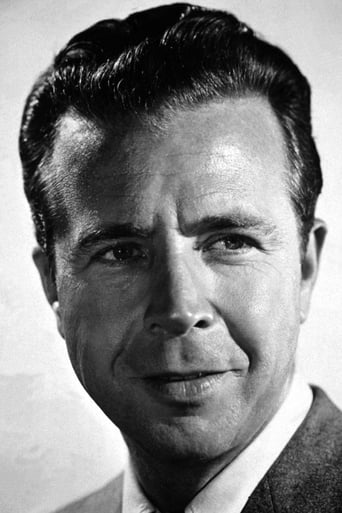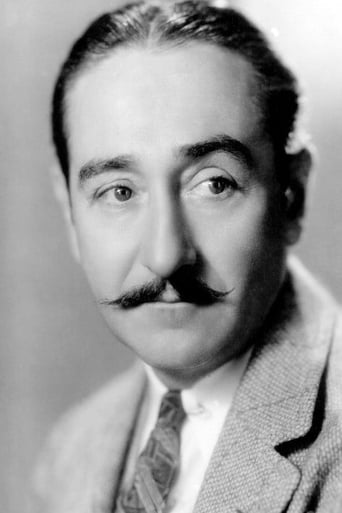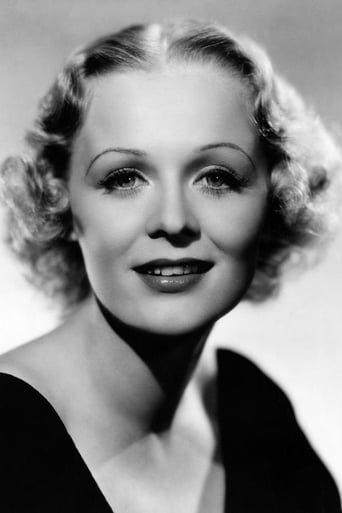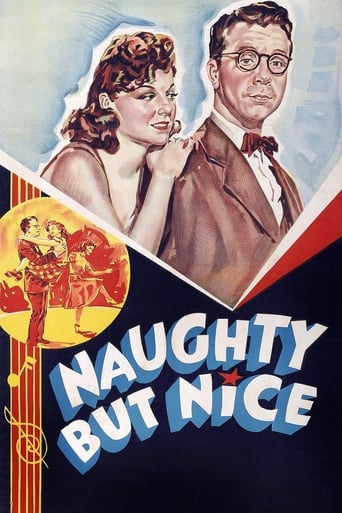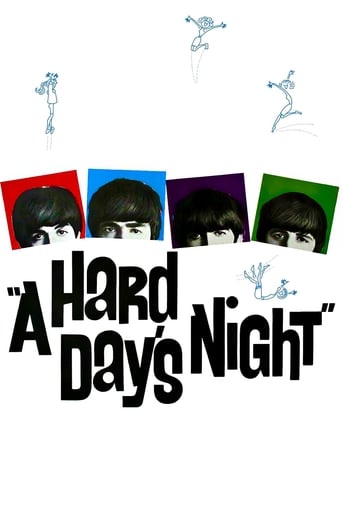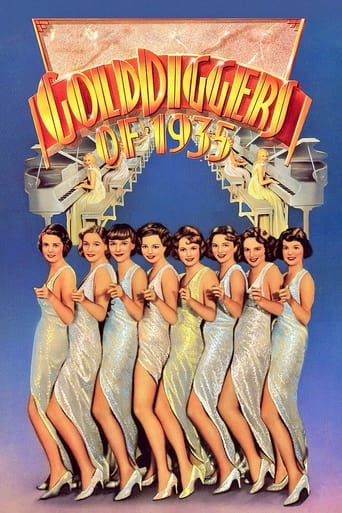

Gold Diggers of 1935 (1935)
Romance strikes when a vacationing millionairess and her daughter and son spend their vacation at a posh New England resort.
Watch Trailer
Cast


Similar titles
Reviews
There is really only one reason to watch this. The Lullaby of Broadway number and most particularly from the moment, about midway through, when the massed dancers come on until the 'beyond shocking' murder/suicide.Wini Shaw loses herself to the erotically pounding and relentlessly advancing crowd of young chorines and handsome young dancers "COME AND GET ME!" she shouts and the movie becomes a kind of 'tap dance horror movie'.'Come and get me' has a most sinister sound - it is the invocation to demonic possession, Dionysian surrender and can only end in death. In the beginning and end of the number we have the face of Wini Shaw turn into a skull-like Manhattan, creepy in itself.Here we have Busby Berkeley turn his flawless 'beauty machine' of monstrously huge chorus lines into a kind of 'death machine'. What was he thinking! Did he even understand himself how great this was?
This was the last released of 5 films currently included in a Busby Berkeley films collection, consisting of Warners films released between 1933-35. So far, I've only seen "Dames", along with this one. "Dames" clearly was more entertaining than this one, to me. Some previous reviewers have come to a similar conclusion comparing this film to others in the series. The first approximately hour, before the 2 big musical production numbers is especially weak in entertainment value. Both films save the 2 big productions until the last part of the film. Thus, a boring or too inane screen play will make you want to hurry out of the theater before the best parts. In Berkeley's later 3 films costarring Judy Garland and Mickey Rooney, one of the big production numbers occurred midway in the film, and there were often smaller musical numbers early on. I consider that a better, and safer, format. This film contains some commonalities and differences from the other 4 films in this series. Although Busby was the chief choreographer for all, each of these films had a different director. This is the only one of the 5 in which Busby was also the overall director. All featured Dick Powell as the male lead or co-lead and main male soloist, and all were scored by the composer-lyricist team of Harry Warren and Al Dubin. This film includes one of their best remembered songs : "The Lullaby of Broadway", used as the featured song in one of the big production numbers. However, it's not a love song. "Dames" includes another of their best remembered: "I Only Have Eyes For You", which was used as a featured love song in an informal setting, as well as in one of the later big productions. This is the only one of the 5 that was released after the Hays commission censorship fully kicked in, around mid-'34. It's also the only one that lacks Ruby Keeler as Powell's ingénue musical girlfriend. It also lacks the charismatic Joan Blondell, who was an important character in several others of the series(and would soon marry Dick Powell). It also lacks Ginger Rogers, who was another significant character in several of these films. In their places , we have only Gloria Stewart. Gloria developed many talents over the years. However, she had no appreciable singing or dancing talent at this time, and appears to have little chemistry with Dick Powell. Thus, she comes across as just another pretty face, among many in this film, whom Powell happens to single out as his girlfriend. Gloria's last film role, some 60 years later, is the one present audiences most remember: as 100 year-old Rose, in "Titanic". Although Gloria lived to be 100, she was actually 86 when this role was shot.Middle-aged Hugh Herbert returned from several other films in this series to reprise his Ed Wynn-like humor. However, in place of Fred Mertz-like Guy Kibbee, as another older male comedic character, we have the quite different Adolphe Menjou, who enjoys shouting at people. He could be an effective part of the comedy, as in the later "You Were Never Lovelier". However, here, both he and Alice Brady, as Gloria's super-rich mother, with her periodic hysterics over her finances or daughter's romantic choices, often come across as more irritating than funny.The two main musical productions consist of 1)many chorus girls supposedly each playing or cavorting around an identical piano, or 2)many male and female dancers dancing in unison, emphasizing the rhythmic sound of their feet. To me, these were far less interesting than the multiple kaleidoscopic patterns formed by the chorus girls, often seen in overhead projections, and other unusual features of the productions in "Dames", and some of the other films in this series. However, the segment with the apparently undulating 2 lines of pianos is an impressive accomplishment. As usual, Busby made the most of sharply contrasting black and white or neon in his musical productions. He would eventually get a chance to choreograph in color, albeit not until his career was in steep decline. "The Gang's All Here", with Carmen Miranda, is probably his first choreography in color. It certainly most clearly bears the stamp of classic '30s Warners Busby, among the half dozen Busby-choreographed color films I've seen. In the early '50s, he did the choreography for Esther Williams' "Million Dollar Mermaid" water ballets, having previously choreographed a water ballet in "Footlight Parade": part of the present film series. During this period, he also did the choreography for several of Jane Powell's musical comedies. Then, after a decade of no film credits, his last credited choreography was for the Doris Day-starring "Billy Rose's Jumbo": a most underrated musical comedy.
I consider this a failure, mostly because I had been so imaginatively tickled by the wonderful earlier films in the same cycle of Warners musicals.In the earlier Gold Diggers from '33 and Footlight Parade, song and dance were only the voluptuous expression of a hardened heart learning to beat truthfully. The wrap-around into narrative was about the circumstances drawn from the depressions of actual life seducing inspiration out of both participants and viewers. Their gaudiness was eloquent, revealing a heart that was rich in many ways.This is the debut proper of the man who was responsible for staging the visions in those films, the actual films being about this man staging the visions. Both those were about Busby Berkeley making films.Not to imply that the man's talents had reached a certain meridian, because we find here one of the most astonishing set pieces he concocted; pure Hollywood dreaming about a woman dreaming a Hollywood that eventually plunges her to a neon doom. Film history has noted this piece as avant-garde, and has grouped it together with other early attempts at an American surrealism.But having assumed here the reigns of the entire production and not just the dance numbers, Berkeley exemplifies the expressive limitations both the surrogate filmmakers inside those films and the actual filmmakers responsible for them were called to solve; how to integrate his pure images within the environment that gives rise to them? What the actual filmmakers did, Mervyn Leroy in Gold Diggers '33 and Lloyd Bacon in Footlight, was of course to structure their films around the efforts of an impulsive artist learning to frame that intuition that so generously gave him images.Here the man is left at his own devices, with just that intuition to guide him. The result? Dazzling spectacle when the show demands it, but babbling nonsense everything around it. There is no mirror to hold the images, no reflection that reveals soul. Just a weak attempt at a farce of errors, coupled with shenanigans about marriage and money.Oh, it is again about the staging of a show, presumably the one we are meant to be watching. Various people scheme one way or another. But no one is wiser for seeing it.
Three production numbers with the finale being the apotheosis of group tap dancing. The 'Lullaby of Broadway' production number will probably never be duplicated. If one considers the time when this musical was produced, the effect of the Winifred Shaw special(Dick Powell actually finishes off the song)is a wonderful example of encapsulating the fast paced life of the Broadway of the 30's. "I'm Going Shopping With You" is a catchy tune but not of classic standards. Still the production of this number is entertaining."The Words Are In My Heart" does not start out well when first introduced by Dick Powell while sitting in the parked speedboat. Notice the strain on his voice in the line '. . .the moon above makes the mu-sic'. Very strident. He improves on this when he gets an opportunity to sing it again. '. . mu-sic' is much less strained. The production of this number with the pianos, however, is extremely enjoyable. The pianos seem to glide effortlessly across the floor and manage to mesh perfectly. Remember, this was done before computers and much hydraulic equipment. So how was this accomplished? If one looks closely under the pianos nearest the screen, unmistakably you will see a pair of black trousered legs propelling the outline of each piano as it glides into place. Imagine the hours of preparation and drill it took to perform this feat to produce the effect seen on the screen. That's how it was in the Depression 30's. This writer must confess that the visibility of the trousers was not noticeable until pointed out on a program discussing the film within the last couple of years. It certainly was not noticeable to the 12-year old who was fortunate enough to view this classic when it first appeared in the middle of the Depression 30's. These musicals helped to make the Depression bearable.


